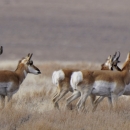About Us
Sheldon National Wildlife Refuge was established in 1931 to: (1) provide habitat for pronghorn, the primary species, and populations of native secondary species (e.g., mule deer, sage-grouse, and song birds) in such numbers as may be necessary to maintain a balanced wildlife population; (2) conserve listed endangered or threatened fish, wildlife, and plants; and (3) use as an inviolate migratory bird sanctuary. Today, the Refuge protects 572,896 acres of wildlife habitat in the northwestern corner of Nevada and is home to over 270 species of wildlife.
The high desert is characterized by wide-open spaces and a variety of landforms. The two most common landforms include narrow canyons that empty into rolling valleys with no drainage outlets to the ocean, and broad flat tables that end abruptly in vertical cliffs. The elevations of these landforms range from a high of 7,294 feet on Catnip Mountain, to a low of approximately 4,200 feet on the northeastern boundary. The area generally decreases in altitude from west to east.
The Refuge currently represents one of the last reasonably intact examples of a sagebrush sagebrush
The western United States’ sagebrush country encompasses over 175 million acres of public and private lands. The sagebrush landscape provides many benefits to our rural economies and communities, and it serves as crucial habitat for a diversity of wildlife, including the iconic greater sage-grouse and over 350 other species.
Learn more about sagebrush -steppe ecosystem in the Great Basin. It provides a variety of critical habitats for a host of species endemic to sagebrush-steppe, including pronghorn, mule deer, greater sage-grouse, pygmy rabbit, migratory birds, desert fishes, and a range of rare plants and invertebrates.
Our Mission
The mission of the National Wildlife Refuge System is to administer a national network of lands and waters for the conservation, management and, where appropriate, restoration of the fish, wildlife and plant resources and their habitats within the United States for the benefit of present and future generations of Americans.
Every national wildlife refuge national wildlife refuge
A national wildlife refuge is typically a contiguous area of land and water managed by the U.S. Fish and Wildlife Service for the conservation and, where appropriate, restoration of fish, wildlife and plant resources and their habitats for the benefit of present and future generations of Americans.
Learn more about national wildlife refuge was created for a special purpose. Some were created to protect migratory birds, others to protect threatened or endangered species or unique habitats, while others fulfill another special purpose. All activities allowed on refuges must be evaluated to make sure each activity will not conflict with the reason the refuge was founded.
The primary purposes of Sheldon National Wildlife Refuge are:
- “…as a refuge and breeding ground for wild animals and birds…”
- “…set apart for the conservation and development of natural wildlife resources and for the protection and improvement of public grazing lands and natural forage resources…”
- “…to conserve (A) fish or wildlife which are listed as endangered species or threatened species…or (B) plants…”
- “…for use as an inviolate sanctuary, or for any other management purpose, for migratory birds.”
Our History
In the early twentieth century, pronghorn populations in Nevada had plummeted as a result of several years of cold dry weather, unchecked livestock grazing, degraded rangelands, and unregulated hunting. By 1920, conservationists including members of the Audubon Society, the Boone and Crockett Club of New York City, employees of the U.S. Biological Survey (later renamed the U.S. Fish and Wildlife Service), and the State of Nevada raised concerns about the plight of the pronghorn. E.R. Sans, an employee of the U.S. Biological Survey, mobilized prominent members of the conservation movement including Dr. Gilbert Pearson, president of the National Association of Audubon Societies, and Charles Sheldon of the Boone and Crockett Club, to address Nevada’s pronghorn problem.
Nevada pronghorn conservationists recognized that forage and habitat were essential for the survival of pronghorn populations and observed that non-native animals including sheep, cattle, and feral horses competed for the same forage and habitat as pronghorn. E.R. Sans convinced the group that George B. Hapgood’s Last Chance Ranch would make an ideal pronghorn sanctuary. For 10 years these conservationists organized, raised money, and lobbied county, state, and Federal governments. Their efforts paid off in 1931 when President Herbert Hoover signed Executive Order No. 5540 purchasing Hapgood’s Ranch and establishing the Charles Sheldon National Antelope Range for the conservation of pronghorn antelope and other native wildlife species. Franklin Roosevelt followed with Executive Order No. 7522, enlarging Sheldon Refuge to over 539,000 acres.
January 26, 1931: Charles Sheldon Wildlife Refuge was established by President Herbert Hoover.
December 21, 1936: Charles Sheldon Wildlife Refuge was combined with the adjacent 540,000 acres Charles Sheldon Antelope Range to create one expansive National Wildlife Refuge.
Other Facilities in this Complex
Sheldon National Wildlife Refuge is part of the Sheldon-Hart Mountain National Wildlife Refuge Complex. You may also be interested in visiting the Hart Mountain National Antelope Refuge in Oregon!
A National Wildlife Refuge Complex is an administrative grouping of two or more refuges, wildlife management areas or other refuge conservation areas that are primarily managed from a central office location. Refuges are grouped into a complex structure because they occur in a similar ecological region, such as a watershed or specific habitat type, and have a related purpose and management needs. Typically, a project leader or complex manager oversees the general management of all refuges within the complex and refuge managers are responsible for operations at specific refuges. Supporting staff, composed of administrative, law enforcement, refuge manager, biological, fire, visitor services, and maintenance professionals, are centrally located and support all refuges within the complex.

